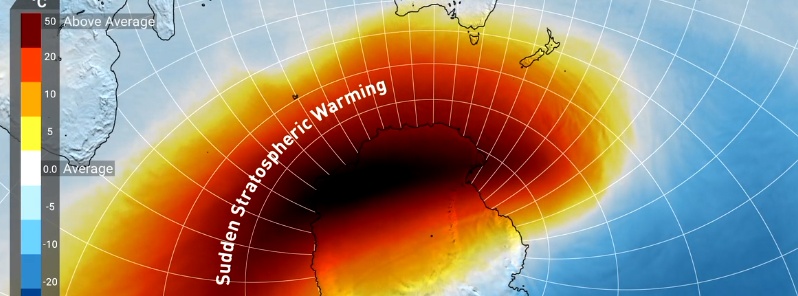Rare weather phenomenon amassing in southern hemisphere – Sudden Stratospheric Warming (SSW)

A rare weather phenomenon for the southern hemisphere – Sudden Stratospheric Warming (SSW) – is amassing in the polar stratosphere. This may lead to unusual or extreme weather in parts of the southern hemisphere (potentially New Zealand) during September and October 2019. SSWs are much more common in the northern hemisphere. You are probably familiar with a major northern hemisphere's SSW event of February 2018 – dubbed the 'Beast from the East' – and odds are you'll be seeing many international headlines with 'September to Remember' in the days and weeks ahead.
SSW occurs when the temperature of the stratosphere (30 – 50 km / 18 – 31 miles above ground) over the South Pole rises by more than 25 °C (45 °F) and NIWA meteorologist Ben Noll says this looks likely to occur next week.
Such events are rare in the southern hemisphere, with only two in New Zealand in recorded times – one in September 2002 and the other in September 2010, NIWA reports. After the SSW in 2002, New Zealand experienced its coldest October in 20 years with below-average temperatures covering much of the country and frequent ground frosts. In 2010 – which is classed as a minor event – a number of rainfall records were broken with well below normal sunshine and very cold temperatures in parts of the South Island.
The SSW is likely to peak between Thursday, August 29 and Monday, September 2.
"For up to about a month after the SSW, polar air masses, known as streamers, can break off from the weakened vortex and move towards New Zealand. It doesn’t guarantee unusual or extreme weather, but it can happen," Noll says.
SSWs are much more common in the northern hemisphere. The southern hemisphere is characterized by a cold Antarctic continent surrounded by relatively warm seas, leading to a more stable circulation around Antarctica than in the Arctic where a relatively warm Arctic Ocean is surrounded by cold continents in winter.
In the southern hemisphere's winter, a ring of stormy and freezing weather encircles Antarctica. Known as the polar vortex, it is usually very good at keeping harsh, wintry conditions locked up close to the pole. When a SSW occurs, it can help to weaken or displace the polar vortex in the stratosphere, which then filters down onto the tropospheric polar vortex and influences weather patterns.
Featured image credit: NIWA

This SSW could effect Atlantic basin?After this many hurricains seem to be develop
it is as predicted by allot of paleo climate people.. we are gong into a grand solar min as was in the 15th century expect allot of death in the next 5 to 10 years as the snowflakes are weeded out… Pray always and prepare…. food WILL become scarce in the very near time frame…. Sorry man made climate nut jobs ITS THE SUN She’s going to sleep and that will change a ton of things on earth….
There is a big difference between back then and now. Mainly that we are in a Warm Period. The 15th century is considered to be the harshest century for adverse weather by many scientists. That was in the middle of a Cool Period.
The cooling which is about to take place is a shorter term cyclical event, aka Gleissberg or grand minimum. Depending on what exactly nature is up to the NH mainly will experience a cool trend into the mid 2030s, imo.
That means that many of the intervening years over the next 16/18 years will be below average in temps. These natural cyclical cool spells also correlate at times with large volcanic eruptions which add to the depth of the cooling trend. Maybe that is what constitutes the difference between a Gleissberg cycle, and what we call a grand solar minimum.
Australia~we are on the turn now from winter, to spring, this is unusual, and will bring on an early spring i feel. but will cool down again very quickly, damaging the new growth, even young crops. i wonder if this will mimic the US winter from hell they just endured?
I wonder it these stratospheric warming events will be more common with climate change. I could of course cool us down a little.
Hi teo I live in the eastern cape south Africa I will keep you posted as things progress at the moment it’s 20 degrees at 5 am in the morning very unusual thanks
Thank you!
Nice report, although the use of red in the illustration kinda gives the event an Armageddon feel! : )
Thanks for your work! Enjoy reading your observations! Did you see the photo of the massive lightning bolt in Poland? It was in the tatra mountains a couple of days ago. Keep up the good work! Thanks Harlan from central Texas
Keep up the awesome work, Teo. Greetings from Croatia
Thank you, Nei!
I didn’t see a typo for 202 instead of 2002.
Pardon me, but wasn’t that what HAARP was all about? Heating the upper atmosphere with raw power pumped through antenna arrays?
It’d be just like one of these countless loose cannon, to fire that old monster up again.
Agreed
HAARP was recently sold. We will be very fortunate if they haven’t already been hacked for a boatload of bitcoins.
interesting. Thanks for posting. Didn’t know about this phenom. Btw, there is a missing zero in one of your years above. You wrote 202, when you meant 2002.
A minor typo in your dates
Thank you, Paul! It said 202 instead of 2002.